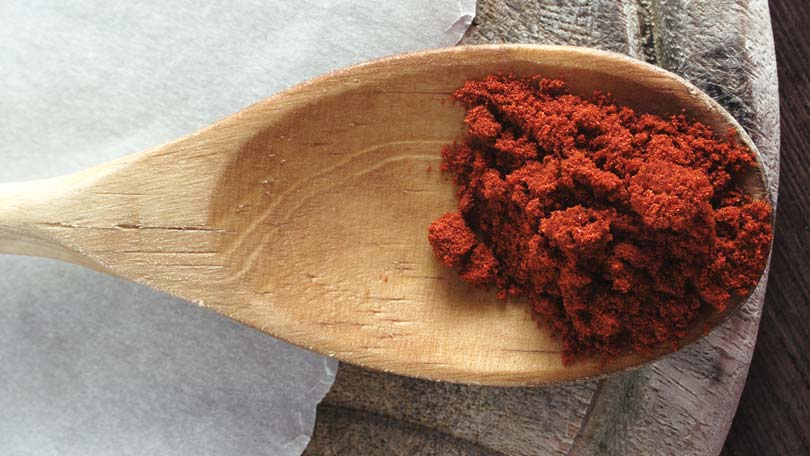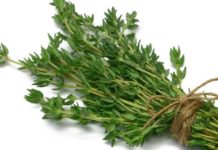
Paprika, or Capiscum annuum, is the ground fruit of a Capiscum family pepper plant often referred to as pimento (the same pimento found at the center of an olive). Originally native to tropical regions paprika peppers, like most other plants in the pepper family, have been cultivated to grow in most regions around the globe (peppers are amongst the most cultivated plants in the entire world). Paprika was most likely spread to Europe by Turkish and Bulgarian travelers, and made its way successfully to Spain, Hungary, and Eastern Europe; Spanish and Hungarian cuisines are now closely associated with paprika use.
Characteristics
Paprika is made from the ripened, dried, ground fruit of the Capsicum annuum. The peppers are deep or bright red in color and are less spicy than chilli peppers. The plants themselves vary in size depending on cultivation and region, and the fruit has been bred to be largely uniform; some varieties are conical while others are more rounded, but the flavor and coloring tends to be the same. The actual plant is annual with dense branches and measures roughly two-four feet high; it bears white flowers along with its green fruit. Paprika peppers are the mildest of all the chilli varieties and therefore, as far as spices go, are a bit more versatile; the spice can be added more liberally to a wider array of dishes without rendering food too spicy or inedible. Ground paprika is vibrantly red, and can liven up the color of pale dishes when added to sauces or sprinkled on top. The spice generally is warmer and sweeter than other peppers with sweet and peppery bouquet.
There are two main varieties relevant to this particular discussion: Hungarian and Spanish. Spanish paprika is called pimenton and comes in different grades: docle (sweet), agridulce (semi-sweet), and picante (hot). Hungarian paprika, which is considered more potent and intense in flavor than pimenton, is the better bet for non-Spanish cuisine. As a side note, some Hungarian paprikas are cut with cayenne pepper and can be hotter than expected.
Common Uses
Paprika is closely associated with Hungarian and Spanish cuisines, and is utilized in some island and tropical cooking as well. Some Hungarian dishes are even referred to as ‘paprikas’, and are defined, obviously, by their use of the spice. Amongst these are the well known dishes goulash and paprikash. It is used in spicy sausage and cured meats, and in the characteristic Spanish chorizo. Paprika can additionally be added to marinades, dressings, soups, stews, and broths, as well as in casseroles or pilafs, and contains a natural emulsifier which makes it useful in sauce making. The spice has also been used with seafood, cheeses, spreads, dips, and in the smoking process; it can be used to color foods and sauces, and is a good garnish on appetizers or hors d’ouvres.
Peppers in general are nutritious and contain solid amounts of vitamins C and A. Paprika unfortunately does not have much vitamin C (the drying process breaks it down before we use it), but is a good source of the phytochemical betacarotene (which is easily absorbed by the body and is good for the eyes). The capsicum family is general has been used as a natural laxative, anti-inflamatory, and anesthetic. The peppers are also thought to help improve circulation, and may have enough antioxidants to help in fighting the inflammatory diseases like heart disease or cancer.
Use and Storage
Paprika has an unfortunately short shelf life. It can be purchased easily in most stores or via the internet, but should only be bought in small batches – unused amounts can lose their potency and go to waste. It should always be stored in an airtight container out of direct sunlight.
Use It:
- in sausages, spicy meat dishes, or in ground meat for tacos
- in goulash and other Hungarian inspired recipes
- to season soups, bean dishes, or pilafs
- to color legume and rice dishes
- in sauces, marinades, dressings, and broths
- in cheese dips and spreads
- as a garnish for potatoes, eggs, or other pale ingredients
- to season zucchini, squash, and other mellow flavored vegetables
- in spice rubs or blends
- sprinkled on deviled eggs and other party treats
Recipe using Paprika
Grilled Spiced Chicken Sandwiches
4 skinless, boneless chicken breasts
4 slices Colby or pepper jack cheese
1 teaspoon paprika
½ teaspoon garlic powder
½ teaspoon onion powder
Salt and pepper to taste
In a small bowl mix dry ingredients. Drizzle chicken with a bit of olive oil and rub in carefully. Sprinkle mix liberally onto both sides of chicken breasts, giving it a moment to absorb. Grill until nicely browned and cooked all the way through. Top with cheese. Serve on a hard roll with sautéed onions or mushrooms, lettuce, and tomato and a splash of BBQ sauce.




